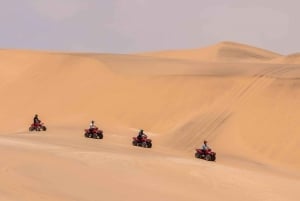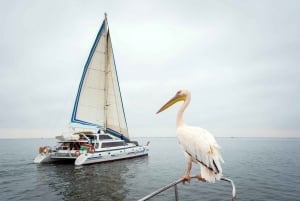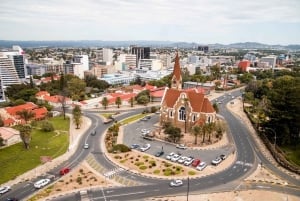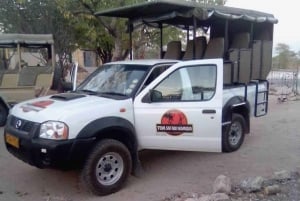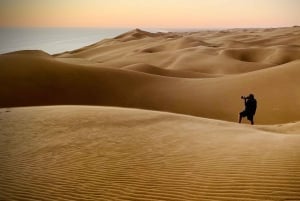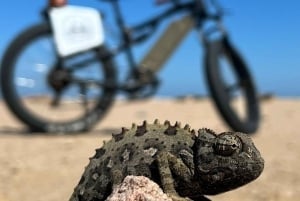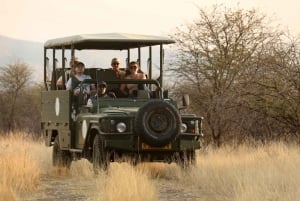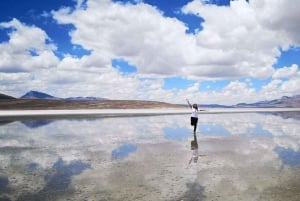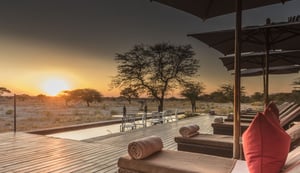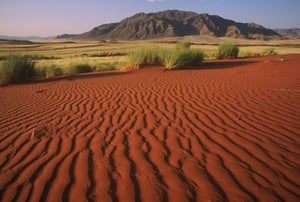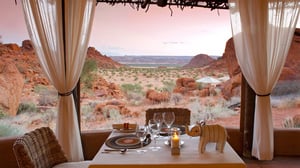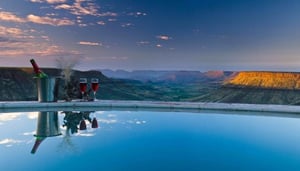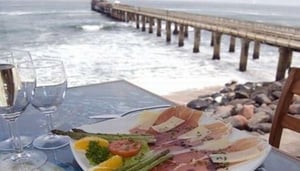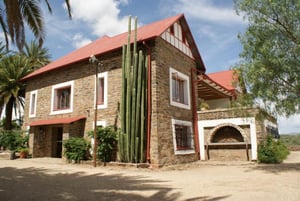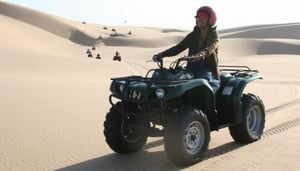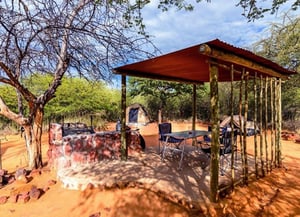Namibia National Parks
Namibia’s national reserves and game parks are owned by Government and managed on its behalf by the Ministry of Environment and Tourism. Since the independence, the private sector has become increasingly involved in wildlife conservation and there has been a rapid escalation in the number and size of private conservation areas. Most park accommodation is managed by Namibia Wildlife Resorts and bookings can be done via their central reservations office. Many private reserves and lodges are situated either bordering or in close proximity and offer visits to the park in their scheduled activities.
(Travellers should be aware of the fact that the majority of the facilities in the parks are not conforming to standards, so before starting the trip personal advice should be considered, unless your are a seasoned traveller and prefer to camp and rough it.)
Mahango Game Reserve
The park, on the banks of the Okavango river, consists of riverine forests, flood plains, baobabs and are inhabited by herds of elephants, red lechwe and more than 400 bird species.
Visitors should exercise caution near rivers in the Caprivi and Kavango as there are crocodiles and hippos to be found int the water.
Caprivi Game Park
Between Angola and Botswana it makes up almost the entire central Caprivi and extends about 180km from the Okavango River in the west to the Kwando River in the east.
Covered in woodlands that are mostly dominated by wild seringa, copalwood zambezi teak, wild teak it plays sanctuary to 35 of the smaller game species while elephant, roan, kudu, buffalo and 339 bird species roam the wetlands.
Visitors with small vehicles might not see many of these animals, as the terrain is extremely sandy, however there are 4X4 routes along the western bank of the Kwando River.
Mudumu National Park
Here you may find some small populations of sitatunga, red lechwe and spotted necked otter amongst many hippos and crocodiles frequenting the waterways.
Other animals that can be found here are elephant, buffalo, roan antelope, kudu, impala and zebra as well as 430 bird species.
Mamili National Park
The park boast some of the largest wetlands, oxbow lakes and tree-covered islands the two largest islands in the Kwando/>Linyanti Rivers.
The same bird and animal species occur here as in the Mudumu National Park.
Visitors have to be completely self-sufficient in terms of water, food and fuel as non of these are provided at the campsites.
Khaudum Game Park
Situated in the north east of the country bordering to Botswana and just below the western border of the Caprivi.
The park are a densely wooded wilderness that harbours several big game species like elephant, giraffe, lion, leopard, hyena, jackal and the ever elusive wild dogs, it also have about 320 bird species.
4x4 vehicles are a must for visitors but fuel is only available at Bagani, Divundu Mukwe and Rundu in the Kavango region, as well as Tjumkwe in Bushmanland.
It is highly advisable to visit this remote park in a large convoy or with a local operator, there are some lodges that tour the park, around Tjumkwe.
Mangetti Game Reserve
Located in the Kavango Region the park is mostly used for game breeding by the Ministry of Environment and Tourism.
Excess game are captured and translocated to other reserves like Daan Viljoen Game Park and Hardap Game Reserve or Mangetti reserve in order to insure a healthy genetic strain amongst local game species.
Etosha National Park
Etosha is one of the largest game reserves in Africa.
The large saline depression/pan with its unique vegetation on its edges and abundant wildlife, makes Etosha on of Africa's top game viewing experiences.
Some 114 game species are found in the park and also several are rare and endangered species like the white and black rhino, cheetah and black-faced impala. Etosha’s elephants are the largest in Africa with some of the tallest measuring up to 4 metres.Other abundant species include blue wildebeest, zebra, hyena, lions,leopard, giraffe, various antelope species and about 340 bird species.
The park has about 30 springs and waterholes that provide excellent game viewing and photographic opportunities. Visitors should approach and depart from waterholes slowly and with as little noise as possible so as not to disturb the game, and remain in their vehicle at all times.
Skeleton Coast Park
Duly known as the long stretch of coast north of Swakopmund, however the pristine Skeleton Coast are the restricted area north of Mowe Bay, only accessible through a hand-full of operators.
A pristine and largrly isolated stretch of coastline that has the most amazing array of natural colour with an everchanging and untouched profile by its landscape. Its weather are unpredictable and have the habit of producing four seasons on an hourly basis be it the dense coastal fogs and cold sea breeze caused by the cold Benguela Currrent, or sand storms to perfect summer sunshine, be prepared when traveling to this area. The greater park boast prehistoric clay castles, salt pans near the Agate Mountain that expands as far as the eye can see, seal colonies at Cape Frio and some of the most pristine geological formations on earth. Scattered herds and mostly single wandering animals like gemsbok, springbok, jackal, ostrich and hyena can be found on the coastal plains, while desert-adapted elephant, black rhino, lion and giraffe roam up and down the dry river courses.
Cape Cross Seal Reserve
Situated about 130 km north of Swakopmund (Arctocephalus pusillus) the largest of the world’s nine fur seal species breed at this colony between November and December when as many as 150 000 of these animals gather at Cape Cross. It was here that a Portuguese navigator, Diego Cao erected a stone cross in 1486 when he negotiated the west-coast of Africa, close by is a private lodge that provides a well received haven against the coastal elements.
National West Coast Recreation Area
This is the 200km stretch of coastline between the Swakop and Ugab rivers. Lichen fields are extensively found here between the dunes and on coastal plains,they depend on coastal fog for survival and are extremely slow growing, destroyed when vehicles drive over them it is recommended not to go off-roading anywhere when visiting the area, as these take thousands of years to re-grow.
Visitors are cautioned that off road driving is not allowed everywhere in the National West Coast Recreation Area and can cause a hefty fine against perpetrators. Along the coast at Mile 14, 72, 108 and Jakkalsputz are campsites providing basic amenities for anglers. In the centre of this area is Swakopmund and provides not only all the amenities you will wish for but are the country's adventure and outdoor sport haven, so be sure to do some sand-boarding, quad-biking or sailing when in the area.
Waterberg Plateau Park
The park is situated 60km east of Otjiwarongo and 300km north east of Windhoek. The park is home to about 25 game species and over 200 bird species, most of these being very unique in size and quality as the plateau are isolated from surrounding areas. Here you will find the only natural foot and mouth disease free population of buffalo in Southern Africa. Vegetation changes dramatically from acacia savannah at the foot of the plateau to lush-green sub-tropical dry woodland with tall trees and grassy plains at the top.The area's history is very important to the local Herero culture and many a colonial ruins and graves can be found in the park.
Von Bach Game Reserve
This reserve is situated 3.5 km south of Okahandja and extends over an area of 43 km. The huge dam in the centre of the park has become a popular venue for aquatic sports like water skiing, yachting, wind surfing and boating.
Visitors can explore the surrounding nature reserve on foot however game viewing opportunities are limited.
Daan Viljoen Game Park
Situated in the rolling hills of the Khomas Hochland just west of Windhoek, it might be small (3,953ha) but are home to a relative large population of game species such as kudu, springbok, gemsbok, eland, red hartebeest, hartmannsmountain zebra, blue wildebeest, baboon, klipspringer, steenbok and rock& dassie.
Interesting bird species to look out for are the Ruppell’s parrot, Monteiro’s hornbill, Carp’s tit, Rockrunner and Whitetailed shrike. Recently the tourism facilities have been privatised and now boast a health and wellness establishment.
HardapGame Park
With the capacity of 323 million cbm and a surface area of 25sq/km, Hardap dam remain Namibia’s largest dam. The reserve is divided by the dam into a norther and southern section and the largest game concentration is found in the southern section. The game to be seen in this area are kudu, gemsbok, springbok, zebra, red hartebeest and steenbok. The dam is home to one of Namibia’s three largest colonies of white pelicans, greater flamingos, white breasted and reed cormorants, darters, African spoonbills, osprey and African fish eagles are also found in this ares.
Namib-Naukluft Park
This is one of the country’s major tourist attractions. The vast wilderness of almost 50 000 sq/km contain key features such as Sossusvlei, Sesriem, the Welwitschia Trail, Sandwich Harbour, the Naukluft Mountains and the Kuiseb Canyon.It hosts the largest dunes and most of the Namib Desert sand sea, it haves plenty of good roads and top lodges to explore.
Naute Recreation Resort
Situated 50 km south west ofKeetmanshoop the Naute Recreation Resort is Namibia’s third largest dam, surrounded by flat-topped ridges and large rust-coloured boulders. The area harbours a variety of birds, including aquatic species, has a peace-full atmosphere and appeals especially to fresh-water anglers and watersports enthusiasts, although as yet there are no facilities here other than camping sites, nearby establishments will make up for what the park lacks.
Fish River Canyon Park
The Fish River Canyon Park including the Ai-Ais Hot Springs Resort and Huns Mountains are incorporated into one conservation area, although The Huns Mountains section is not yet open to the public,it remains the second largest natural gorge in Africa.It boast one of the most extreme hiking trails in the canyon and rewards the few that dare hike it with natural hotwater springs at the end of the trail and facilities of Ais-ais.


